|
|
|
| My Favourite Planet > English > People > Aulus Claudius Charax |
 |
back |
Aulus Claudius Charax |
|
|
| |
Aulus Claudius Charax
of Pergamon
Aulus Claudius Charax of Pergamon (Αὖλος Κλαύδιος Χάραξ Περγαμηνός, circa 115 - after 147 AD) was a Roman citizen, military commander, politician, priest, philosopher and historian during the reigns of emperors Hadrian and Antoninus Pius. His full name may have been Aulus Julius Tiberius Claudius Charax. [1]
He was known to scholars for centuries simply as "Charax of Pergamon", a historian, priest and philosopher, from mentions and quotations by later writers, particularly an epigram quoted in the Byzantine encyclopaedia, the Suda:
"Charax of Pergamon, a priest and philosopher. I found in an ancient book the following epigram about him:
'I am Charax, a priest from the venerable heights of Pergamon, where once Telephos, blameless son of blameless Herakles, fought a war against city-destroying Achilles.'
He is much later than the ones after Augustus. At any rate, in the second of the books he mentions Augustus, as having become Caesar long ago, and in the seventh [book] Nero and the emperors after him. He wrote Greek and [Roman?] histories, in 40 [books]." [2]
Inscriptions discovered in Pergamon in 1957 have shed more light on such references and other inscriptions found elsewhere. The key inscription is on the base of a statue dedicated to Charax by the city of Patrae (Patras, Peloponnese) around 147 AD, which contains an outline of his career:
"The city of Patrae [honours] Aulus Claudius Charax, consul, governor of Cilicia-Isauria-Lycaonia, commander of the Second Legion Augusta, curator of the Via Latina, praetor, adlected by the senate among the ex-aediles, quaestor of Sicily, the historian. On the motion of Octavius Chrysanthus." [3]
The three other inscriptions found at Pergamon: a base of a statue dedicated by Charax to Emperor Antoninus Pius [4]; a dedication naming him as grandfather of Aulus Iulius Charax (photo, above right); a dedication on a clipeus (shield) of the propylon of the Pergamon Asclepieion (photo, right).
These and other references to him have allowed a number of scholars to sketch some details of his life, although exact dates and the nature of his personality remain unknown.
His maternal grandfather was Gaius Julius Quadratus Bassus (70-117 AD), a romanized Galatian born in Pergamon. He was legate at Judaea 102/103 - 104/105 AD, suffect consul in 105 AD, proconsul of Asia in 105 AD, governor of Cappadocia and Galatia 114/115 AD, governor of Syria 114/115 AD, and was governor (Legatus Augusti pro praetore) of Dacia when he died in the Dacian revolt of 117 AD. He was married to Julia Iotapa (born circa 80 AD), also known as Julia of Cilicia, a Cilician princess, daughter of King Gaius Julius Alexander of Cetis.
Their daughter Julia Quadratilla Bassa (born circa 100 AD) married Gaius Julius Lupus Titus Vibius Varus Laevillus (circa 95 - after 132 AD), quaestor in Asia in 132 AD. Charax was one of three known sons of the couple, his brothers Aulus Julius Amyntas and Aulus Julius Proculus were noblemen in Ephesus.
The name of Charax's wife is unknown, but his daughter Julia married Gaius Asinius Rufus (circa 110 - after 136 AD), a notable in Lydia in 134 and 135 AD, and senator in 136 AD. A number of his descendants served as Roman officials, and a great grandson, Gaius Asinius Quadratus, was a historian around 200 AD. [5]
Charax was entrusted with various official appointments at a young age, although it is not entirely clear in which order or at what time he held each of the offices mentioned on the Patrae inscription. The posts of quaestor of Sicily, curator of the Via Latina and praetor indicate his promotion through the ranks in the cursus honorum (course of offices) which led to his election to the senatorial class ("adlected to aedicilian rank") in the 130s (perhaps around 137-138 AD), although it appears that he never served as a senator. The election into this class was nominally a matter of the senate itself (as mentioned in the inscription), but it is thought that he may have been promoted by Hadrian personally.
As a leading citizen of Pergamon, one of the most important cities of Asia Minor, he may have met Hadrian during at least one of the emperor's two visits to the province in 124 AD and 129 AD. It seems equally likely that he met Antoninus Pius while the future emperor was proconsul of Asia 134-135 AD.
Around 141-144 AD Charax was a legate (legatus) in Britannia, commanding the Legio secunda Augusta (Augustus' Second Legion), one of three legions which constructed the 63 kilometre long Antonine Wall (Vallum Antonini) in Scotland during the governorship of Quintus Lollius Urbicus. The "Bridgeness slab", an inscribed sandstone distance slab set up by the legion circa 142 AD, discovered at Bo'ness, near the eastern end of the Antonine Wall, may possibly depict Charax (see below).
He governed Cilicia circa 144-147 AD, and was suffect consul in 147 AD. [6] After this date nothing is known of him, but perhaps he returned to Pergamon to pursue his studies of history and take part in building works in the city, particularly at the Asclepieion, where he financed the building of the propylon (monumental gateway), known as "the Propylon of Claudius Charax".
His work of Greek and Roman history, Hellenica (Ἑλληνικά), in 40 books, was still read in the Byzantine era. Only 64 fragments of the work have survived as quotations by later writers, but it appears to have included myths, legends, even a discussion on the genealogy of Homer, and several anecdotal digressions. It was summarized in the 6th century AD geographical dictionary Ethnica (Ἐθνικά) by Stephanus Byzantinus (Στέφανος Βυζάντιος) as Chronika (Χρονικά). [7] Some scholars have understood Hellenica and Chronika to be two separate historical works by Charax.
He was one of many wealthy, well-connected Greeks who thrived under the Roman emperors, held high public offices and were considered among the intelligentsia of their time (see also Herodes Atticus and Arrian of Nikomedeia). |
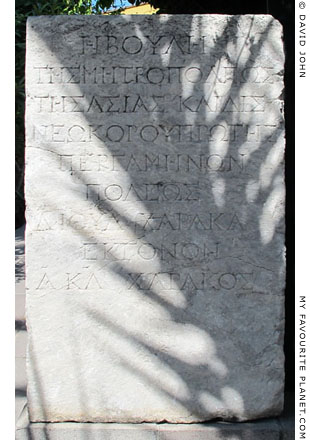
Marble statue base with an inscription of
the boulē (council) of Pergamon honouring
Aulus Iulius Charax, grandson or great-
grandson of Aulus Claudius Charax.
150-200 AD.
Bergama Archaeological Museum.
Inv. No. A 55/61.
Inscription SEG 18:558; AE 1961, 321.
See Pergamon gallery 1, page 14. |
| |
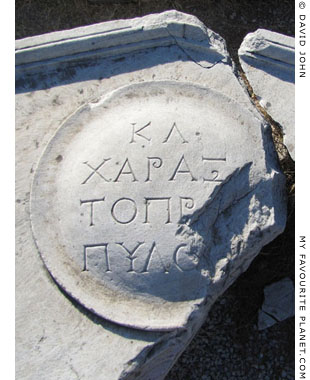
The marble clipeus on the tympanum
of the north hall of the propylon of the
Pergamon Asclepieion, inscribed with a
dedication by Aulus Claudius Charax who
was a priest at the sanctuary and financed
the building of the monumental gateway:
ΚΛ[ΑΥΔΙΟΣ] ΧΑΡΑΞ ΤΟ ΠΡ[Ο]ΠΥΛΟ[Ν]
Cl[audius] Charax [dedicated]
the pr[o]pylo[n]
In situ at the site of the propylon.
Inv. No. 193,7. Inscription IvP III 141.
See Pergamon gallery 1, page 35. |
| |
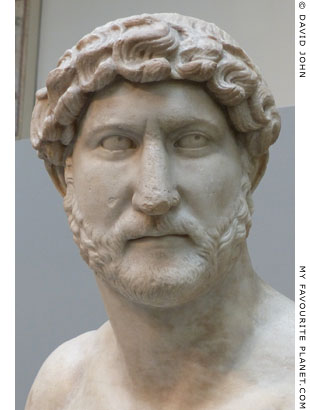
Marble portrait bust of Emperor Hadrian.
117-138 AD. Probably from Rome.
British Museum.
Inv. No. 1805,7-3.94 (Sculpture 1897).
From the Townley Collection. |
| |
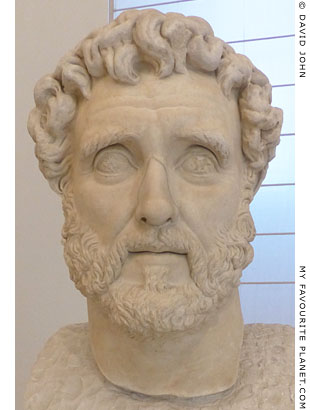
A colossal marble head of Antoninus Pius
from an official portrait bust. After 161 AD.
From the Baths of Caracalla, Rome.
National Archaeological Museum, Naples.
Inv. No. 6078. From the Farnese Collection. |
| |
| |
|
|
| |
| |
 |
| |
 |
| |
 |
| |
 |
| |
 |
| |
 |
| |
George Alvanos
rooms in
Kavala's historic Panagia District
Anthemiou 35,
Kavala, Greece
kavalarooms.gr
|
| |
Olive Garden Restaurant
Kastellorizo,
Greece
+30 22460 49 109
kastellorizo.de
|
| |
Papoutsis
Travel Agency
Kastellorizo,
Greece
+30 22460 49 286
greeklodgings.gr
|
| |
| |
| |
Aulus Claudius
Charax |
The Bridgeness Slab, Legio II Augusta and Charax (?) |
|
 |
|
| |
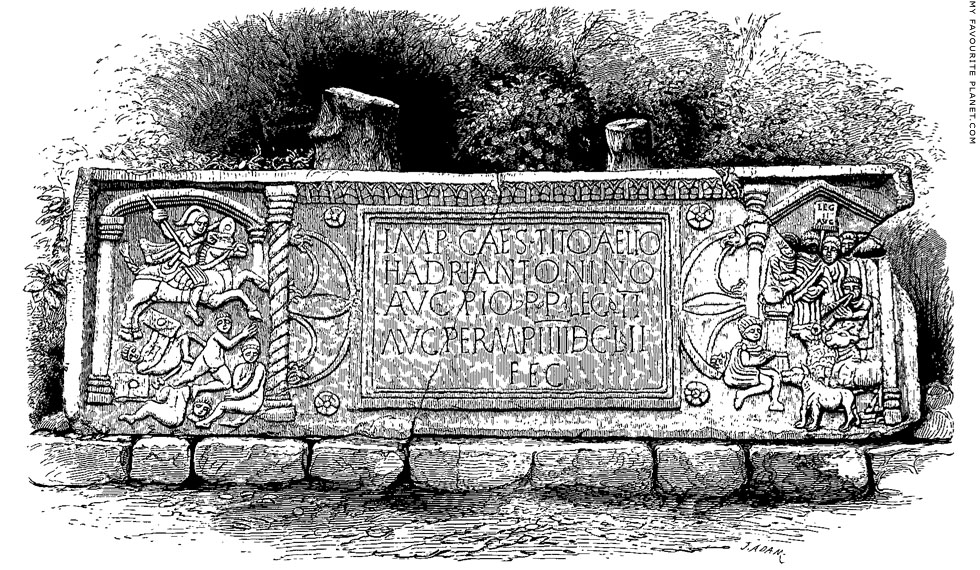
Drawing of the Bridgeness distance slab by J. Adam, showing the slab set up by
Henry Cadell in the garden of his Grange estate, Bo'ness, near to where it was
discovered. He placed the slab on some of the cut sandstone blocks also found
with the slab, and encouraged visits by the public before it was taken to the
Museum of the Antiquaries of Scotland (now the National Museum of Scotland).
Image source: Henry Cadell, Note of a Sculptured Roman Slab recently discovered
on the estate of Grange, Linlithgowshire, and presented to the Museum.
Proceedings of the Society of Antiquaries of Scotland, Volume 8 (1868-9), pages 109-113,
Plate VII. Illustrated PDF at the Achaeology Data Service, University of York. |
| |
In 43 AD, during the reign of Emperor Claudius (41-54 AD), the Legio secunda Augusta took part in the Roman conquest of Britain, commanded by future emperor Vespasian. It was one of three legions permanently stationed in Britain, and remained there until 269 AD. From around 74 AD it was based at Isca Augusta (or Isca Silurum, modern Caerleon, Gwent, South Wales).
The legion was involved in the construction of Hadrian's Wall, which commenced during Hadrian's visit to Britain in 122 AD (although probably already in the planning) and took around six years.
During the reign of Antoninus Pius (138-161 AD) the Romans attempted to expand their territory northwards by attacking southern Caledonia (Scotland), and in 142 AD the legion built part of the Antonine Wall, the northernmost frontier barrier of the Roman Empire. The 63 kilometre long turf fortification with stone foundations and wooden palisades, between the Firth of Forth and the Firth of Clyde, took around twelve years to complete but was abandoned by about 165 AD when the troops withdrew to behind Hadrian's Wall. Quintus Lollius Urbicus, the governor of Britain 139-142 AD, intitiated the building of the wall; the identity of his immediate successor is unknown.
The "Bridgeness slab" (see image above) was discovered in April 1868 at Bo'ness on the southern shore of the Firth of Forth, Scotland, near the eastern terminal of the Antonine Wall. The long sandstone distance slab, dated circa 142 AD, has three sculpted panels: a pictorial relief at each end, and a much-abbreviated Latin inscription in the centre:
IMP CAES TITO AELIO
HADRI ANTONINO
AVG PIO P P LEG II
AVG PER M P IIII DCLII
FEC
"Imp(eratori) Caes(ari) Tito Aelio Hadri(ano) Antonino Aug(usto) Pio p(atri) p(atriae) leg(io) II Aug(usta) per m(illia) p(assuum) IIII DCLII fec(it)"
"To the Emperor Caesar Titus Aelius Hadrianus Antoninus Augustus Pius, Father of his Country, the Second Augustan Legion [dedicates this, having] made 4652 paces [of the wall]."
Roman Inscriptions of Britain, RIB 2139;
Corpus Sculpturum Imperii Romanorum, CSIR I, iv, 68.
The 4652 paces, about 4-6 Roman miles, between Bridgeness and Inveravon, was around a ninth of the length of the entire wall.
On either side of the frame containing the inscription are two rosettes (one at each corner) and a crescent-shaped pelta (shield, from the Greek πέλτη) device with three heads of griffins.
Both the pictorial reliefs are set within representations of roofed stone buildings (aediculae), with Tuscan columns on each side of the image area. There is another, larger, spiral-fluted column on the right side of the left-hand relief, intended to frame the central inscription area, but only the top of the matching column on the other side is visible, the rest is behind the column of the right-hand image. The sculptor appears to have poorly planned the layout of the relief, not allowing sufficient room for the matching column on the right, although it could be that either the right side of the slab was damaged or the space in which the slab had to fit was smaller than originally expected.
The relief on the left shows a victorious Roman cavalryman in full armour, charging on horseback and brandishing a downward-pointing spear in his right hand. On the ground below his horse are the figures of four defeated, naked Caledonians. One holds up a shield in a futile defensive gesture; another falls forward with a spear in his back; a third sits or lies decapitated, with his head lying by his side; and the fourth (perhaps a woman?) sits on the right, looking dejected, with a sword lying at his/her side.
The relief on the right shows seven Romans in civilian robes, sacrificing at an altar; they are performing the souvetaurilia, the ritual cleansing of the legion, presumably following the successful completion of their task. Five figures stand by the altar, and the second from the left, holding a patera (libation bowl) in his right hand, pours a libation over the altar. Behind these figures is a vexillum (the legion's cavalry standard) bearing the inscription "LEG II AUG".
In front of the altar, to the left a man crouches, and to the right a tibicen (flautist) plays a double flute to accompany the ritual. Between them stand the sacrificial victims (from back to front): a ram, a bull and a pig.
It is thought that the figure holding the patera may be the commander, acting as priest in the ritual, and that this may be Aulus Claudius Charax. Unfortunately, the slab is cracked and damaged around the area of the faces of the figures, although it is not known whether the sculptor even intended to depict individual portraits of the participants; the scene may be a generalized representation.
As David J. Breeze has pointed out (The flag of Legion II Augusta on the Bridgeness distance slab, see below) it is far from certain that the entire legion was involved in the Caledonian campaign or the building of the Antonine Wall. It appears that, as with the other two legions (the 6th and 20th), only a vexillation (detachment) may have been sent to Caledonia, while the main body of troops continued their duties from their home base. If this was so, did Charax lead them in the north?
Charax is assumed to have had no previous military experience, since the little information we have about his career indicates he had previously held only offices for which martial prowess would not be necessary. On the Patrae inscription, however, he is mentioned as a strategos (στρατηγὸν, general), although this is usually translated as praetor, an office more akin to a magistrate. [3] It has also been suggested that Antoninus Pius' campaign in Caledonia was undertaken more for reasons of political prestige rather than real strategic advantage or territorial ambition, and that the appointment of a loyal noble such as Charax as a senior officer was meant as a mark of honour, though not necessarily a sign of confidence in his tactical skills.
If Charax's appointment as legate was a matter of politics and prestige, he may not have needed to personally lead a detachment to Scotland to have reaped the benefits for his reputation and career of its success there. It was usual to depict the emperor as the symbolic victor on such monuments, but A. R. Birley (The Roman distance slab from Bridgeness, see below) has argued that for various reasons neither the cavalryman nor the figure with the patera on the Bridgeness Slab depict Antoninus or Lollius Urbicus. Then perhaps we have either one or more depictions of Charax as the legion's commander and (symbolic) victor, one of his sub-commanders (unlikely) or generalized symbolism. The arguments concerning these possibilities remain subjects of enquiry for students of Roman history.
We still have too little information about the Antonine campaign in Caledonia or the military situation in Britannia at the time or Charax himself to be sure of his role in these events. However, the speculation that the historian from Pergamon, known for centuries merely as an obscure name in ancient manuscripts and only recently beginning to emerge as a real historical personality, was present in the lowlands of Scotland and depicted on this slab, is fascinating; and if you never ask you will never know.
David J. Breeze, The flag of Legion II Augusta on the Bridgeness distance slab. Proceedings of the Society of Antiquaries of Scotland, 119, (November 1989), pages 133–142. Illustrated PDF at the Archaeology Data Service, University of York.
David J. Breeze, Q Lollius Urbicus and A Claudius Charax, Antonine commanders in Britain. Proceedings of the Society of Antiquaries of Scotland, 121 (1991), pages 227-230. PDF at the Archaeology Data Service, University of York. Charax's appointment as legate of Legion II Augusta may have resulted from earlier contact with Antoninus Pius when the latter was proconsul of Asia.
E. J. Phillips, The Roman distance slab from Bridgeness, Proceedings of the Society of Antiquaries of Scotland, 105 (1972-4), pages 176-182. Illustrated PDF at the Archaeology Data Service, University of York. A detailed discussion of the sculpture of the slab. Phillips does not mention Charax, but argues that for various reasons neither the cavalryman or the figure with the patera depict Antoninus or Lollius Urbicus.
Joanna Close-Brooks, The Bridgeness distance slab. Proceedings of the Society of Antiquaries of Scotland, 111 (1981), pages 519-521. Illustrated PDF at the Archaeology Data Service, University of York. A discussion of traces of paint found on the slab when it was cleaned and repaired at the museum in the winter of 1979/80. Includes drawings of the back and edges of the slab.
A. R. Birley, The Fasti of Roman Britain, pages 250-251. Oxford University Press, 1981.
Natalie Boymel Kampen (1944-2012), The Art of Soldiers on a Roman Frontier: style on the Antonine Wall. Eve D'Ambra, Guy P. R. Métraux (editors), The art of citizens, soldiers and freedmen in the Roman world, pages 125-134. BAR International series 1526. Archaeopress, Oxford, 2006. PDF at the University of Heidelberg.
Proceedings at meetings of the Royal Archaeological Institute, 26 (1869), pages 174-193. PDF at the Archaeology Data Service. One of the earliest reports, by Major-General Lefroy, of the finding of the Bridgeness distance slab, December 4 1868, pages 178-179.
Inscription RIB 2139, Distance slab of the Second Legion Augusta.
Volume One of The Roman Inscriptions of Britain, at Scott Vanderbilt's RIB online. An astonishingly good website with searchable inscriptions, detailed descriptions, illustrations, translations, bibliographies, links... and a lot of hard work by Mr Vanderbilt.
L. F. J. Keppie, The building of the Antonine Wall: archaeological and epigraphic evidence. Proceedings of the Society of Antiquaries of Scotland, 105 (1972-1974), pages 151-163. PDF at the Archaeology Data Service.
L. F. J. Keppie, The distance slabs from the Antonine Wall: some problems. Scottish Archaeological Forum, 1 (1975), pages 57-66.
L. F. J. Keppie, Roman distance slabs from the Antonine Wall, a brief guide. Hunterian Museum, University of Glasgow, 1979.
The Antonine Wall, illustrated page about the wall at scran.ac.uk, the website of the Scran Trust, part of the Scottish charity Historic Environment Scotland.
legiiavg.org.uk, website of the re-enactment group Legio Secunda Augusta. |
|
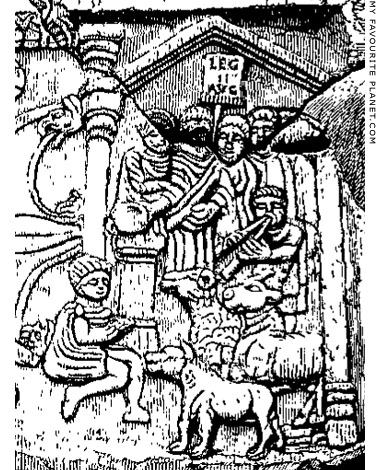
Detail of the drawing of the Bridgeness distance slab
by J. Adam (see above), showing the sacrifice scene
on the right-hand relief.
The relief is now in the National Museum of Scotland,
Edinburgh. Inv. No. X.FV 27.
Height 86.4cm, width 274.3 cm;
central panel, height 66 cm, width 106.68 cm.
A sandstone replica of the relief was unveiled
in September 2012 in Kinningars Park,
Bridgeness, Bo'ness, near the place where the
original was discovered in 1868.
There are also casts in:
the Hunterian Museum, University of Glasgow,
the Great North Museum, Newcastle upon Tyne,
the Museum of Archaeology, Durham. |
|
| |
Aulus Claudius
Charax |
Notes, references and links |
 |
|
1. Charax's full name
See: Anthony R. Birley, The Roman government of Britain, pages 253-254. Oxford University Press, 2005. At googlebooks.
2. Charax in the Suda
The Suda or Souda (Σοῦδα), a Byzantine encyclopaedia of the ancient Mediterranean world, written in the 10th century AD.
εἰμὶ Χάραξ ἱερεὺς γεραρῆς ἀπὸ Περγάμου ἄκρης, ἔνθα ποτὲ πτολέμιξεν Ἀχιλλῆϊ πτολιπόρθῳ Τήλεφος, Ἡρακλῆος ἀμύμονος υἱὸς ἀμύμων.
FGrH 103 (see note below).
See: Suda, Χάραξ, Adler number: chi, 95. Suda On Line at stoa.org.
3. Dedication to Charax by the Patrae
The inscribed marble statue base was found with another, dated 150-200 AD, dedicated to his grandson or great grandson Aulus Iulius Charax (see photo above right). They were discovered by chance in Bergama in 1957 during the digging of a foundation for a house (see Pergamon gallery 1, page 14).
Πατρέων ἡ πόλις
Α(ὖλον) Κλ(αύδιον) Χάρακα
ὕπατον Ῥωμαίων,
ἡγεμόνα Κιλικίας
Λυκαονίας Ἰσαυρίας,
ἡγεμόνα λεγιῶνος βʹ Αὐγ(ούστας)
ἐπιμελητὴν ὁδοῦ
Λατείνης,
[σ]τρατηγὸν Ῥωμαίων,
[κατ]αλεχθέντα ὑπὸ τῆς
[συ]νκλήτου
εἰς τοὺς ἀγορανομικούς,
ταμίαν Σικελίας,
τὸν συνγραφέα.
εἰσηγησαμένου
Ὀκταβίου Χρυσάνθου.
|
The city of Patrae [honours]
Aulus Claudius Charax,
Roman consul,
governor of Cilicia-
Isauria-Lycaonia,
commander of the Second Legion Augusta,
curator of the Via
Latina,
Roman praetor (general),
adlected by the
senate
among the ex-aediles,
quaestor of Sicily,
the historian.
On the motion of
Octavius Chrysanthus. |
Bergama Archaeological Museum. Inv. No. B 55/61.
Inscription SEG 18:557; AE 1961, 320.
Height 87.5 cm, width 51 cm, depth 51.5 cm.
See:
Christian Habicht, Zwei neue Inschriften aus Pergamon, Istanbuler Mitteilungen 9-10 (1959-1960), pages 109-127. Deutsches Archäologisches Institut, Abteilung Istanbul, 1960.
Christian Habicht, Die Inschriften des Asklepieions, Altertümer von Pergamon VIII, 3. de Gruyter, Berlin, 1969.
4. Statue dedicated to Antoninus Pius by Charax
The inscribed statue base, dated to 138-161 AD, was found near the propylon of the Pergamon Asclepieion. The statue is lost, however a number of fragments of statues of renowned persons and emperors found nearby are now in the Bergama museum.
Αὐτοκράτορα
Καίσαρα θεοῦ
Ἁδριανοῦ υἱὸν
Τίτον Αἴλιον
Ἁδριανὸν
Ἀντωνεῖνον
Σεβαστὸν Εὐσεβῆ
Ἄριστον
Κλαύδιος Χάραξ
τὸν τῆς πατρίδος
καὶ τῆς οἰκουμένης
καὶ ἑαυτοῦ εὐεργέτην
|
|
|
Bergama Archaeological Museum.
Inscription IvP III 8.
Height 128 cm, width 61 cm, depth 59 cm.
5. Charax's genealogy
Roman genealogies present one of the thorny undergrowths of ancient history. Family links between persons are often assumed from thin evidence, based on vague or ambiguous mentions in literature and on inscriptions, where names are frequently abbreviated. Roman nomenclature was a complicated business, with conventions of praenomen, nomen, and cognomen (the tria nomina), as well as agnomen, cognomina ex virtute, adoptive cognomina and filiation, as can be seen by the purportive full name of Charax himself. But when shortened, many names appear similar, leading to much confusion.
In this case, the author can take no responsibility for errors in the above sketch of Charax's family tree, but, as ever, would love to hear from you if you have comments, criticism or more information. Please get in contact.
6. Suffect consul
A consul suffectus was a high-ranking official appointed to replace an elected consul who had died or resigned.
147 AD has been calculated to be the year Charax was suffect consul after the Fasti Ostienses fr. 38.
7. Charax fragments
Karl Müller, Fragmenta historicorum graecorum, Volume III, Charax Pergamenus (Characis Pergameni Fragmenta), pages 636-645. Editore Ambrosio Firmin Didot, Paris, 1849. In Latin and Greek at Internet Archive.
"Fragments" of ancient works are usually quotations, paraphrases, citations or summaries by later writers. Collections of fragments may include texts of ancient papyri and inscriptions.
Fragments of lost works by ancient Greek historians are often referred to by the abbreviation FGrHist or FGrH (from Fragmente der griechischen Historiker, Fragments of the Greek Historians) followed by a number, for example FGrH 103 for the quotation from the Suda above. These designations are based on the vast collection Fragmenta historicorum graecorum by the German philologist Karl Müller (1813-1894), published in five volumes (volume 5 in two parts) 1841-1884, containing fragments of over 600 authors from the 6th century BC to the 2nd century AD.
Fragmenta historicorum graecorum is available online at the Internet Archive, see link above,
and at DFHG - Digital Fragmenta Historicum Graecorum, dfhg-project.org.
Felix Jacoby (1876-1959) revised and updated the collection in his Die Fragmente der griechischen Historiker. The first 3 of a planned 6 parts were published in 15 volumes between 1923 and his death.
Since 1998 an international pool of editors has been working on updating and completing Jacoby's work, in a project known as "Die Fragmente der griechischen Historiker. Continued", expected to be completed in 2017. The entries already completed are published online by the publisher Brill under title Brill's New Jacoby (BNJ), available by subscription:
referenceworks.brillonline.com/browse/brill-s-new-jacoby |
|
|
| Photos and articles © David John 12 February 2017 |
 |
Visit the My Favourite Planet Group on Facebook.
Join the group, write a message or comment,
post photos and videos, start a discussion... |
|
|
| |
| Copyright © 2003-2025 My Favourite Planet | contributors | impressum | contents | sitemap |
| |















